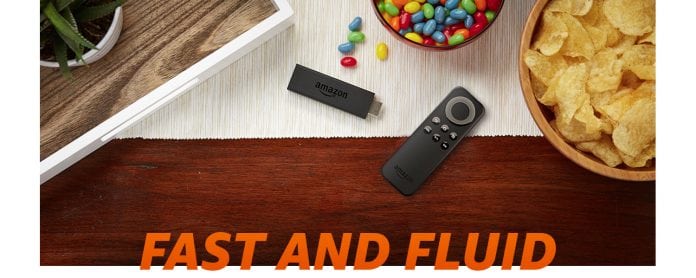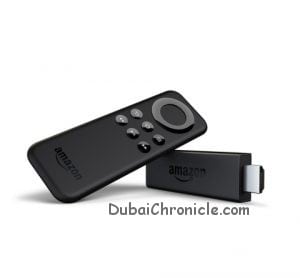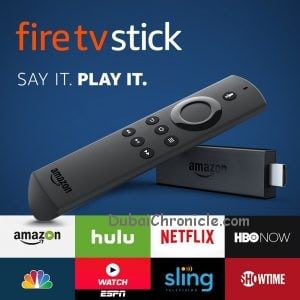
 If you are wondering what is an Amazon Fire TV Stick that works in over 100 countries around the globe, we have the detailed answer here.
If you are wondering what is an Amazon Fire TV Stick that works in over 100 countries around the globe, we have the detailed answer here.
To start with, it is the second generation of Amazon’s video streaming device. You can stream video from Amazon Prime, as well as Netflix and the full roster of the catch up services. There are plenty more apps besides, including Prime Music and Spotify, also an access to Amazon’s growing games library.
The Amazon Fire TV Stick only goes up to Full HD 1080p resolution. If you want 4K Ultra HD or HDR video, check out the full-size Amazon Fire TV 4K or Roku Streaming Stick Plus which right now slightly cheaper.
The second generation’s interface has had a complete overhaul to make it look sleeker. It is also easier to use. The real benefits of the new Stick are its faster processor and improved Wi-Fi.

Design and build
The Amazon Fire TV Stick looks a bit like a memory stick on steroids. It is designed to plug straight into an HDMI port on your TV. It’s a neat all-in-one design housed in plastic.
At 9cm long and around 3cm deep, it will need a bit of room on your TV back panel though, particularly when you consider making room for its micro USB cable power supply. Thankfully, Amazon includes an HDMI extender in the box to free up some space.

The accompanying remote is the same one that you’ll find included with the pricier Amazon Fire TV box. It’s pretty simple, offering a D-pad for navigation, a handful of playback controls and the all-important voice input key.
Setup and interface
Setting up your Fire TV Stick is really simple. Just plug it into a spare HDMI slot on your TV, and its USB cable into a power source. Some on-screen instructions will get your Alexa remote paired and the Fire TV Stick hooked up to your home network. Once you’re signed into your Amazon account, you’re ready to go.

If you’re familiar with the previous Fire TV Stick, you’ll notice immediately that the interface has been redesigned. The main navigation menu has moved from the side to along the top, and a new picture-led carousel with suggested content dominates the top half of the screen. The idea is that the Fire TV Stick will learn your viewing habits over time and tailor this to you, with video teasers to draw you in. During a week’s testing, the selection it surfaced improved to include programmes and films I’d be more likely to choose, including content from other providers like Netflix.
Detail pages have been improved too, with a large picture backdrop and more in-depth programme information. Once you start to watch a show, clicking upwards on the remote will open up Amazon’s X-Ray IMDb feature, for finding about more about the cast.
Besides downloading apps, the homepage is the only place to be. In a side-scrolling menu beneath the carousel, you’ll find your recent shows and apps for quick access. Beneath that, you can browse and organise your downloaded apps, scroll through several menus of Prime suggested content, and even one for Netflix.
Amazon Fire TV stick interface
While Amazon Prime content is still its bread and butter (and dominates its menus) it’s not as difficult to find content from other providers as it was before.
For example, Amazon Prime offers Breaking Bad as a paid-for box set, whereas it’s free to watch on Netflix. If you search for it, Fire TV will suggest you watch it on Netflix first, with the option to buy it in a “More Ways To Watch” menu. It feels more like it’s working for the user, and not for itself, which is how it should be.
It’s still very much a device aimed at Prime subscribers though, and I’d certainly recommend signing up for the service to get the most out of it. With its new monthly subscription option, it’s much more accessible now too. If you’re not interested in Prime, you may well find you’re better serviced by a Chromecast or similar streaming stick.
Features
Alongside its new interface, the Amazon Fire TV Stick has seen some hardware upgrades too, including a new quad-core processor and improved Wi-Fi.
The new chipset promises to be 30% quicker, while the 802.11ac Wi-Fi ensures more stable streaming, quicker downloads and faster buffering. You’ll really notice this improvement if your Fire TV Stick is a little further away from your router too, thanks to a better performance range.
There’s still 8GB of on-board storage for apps and games and the same 1GB RAM as its predecessor, which is enough.
Performance
Scrolling through the menus, it’s clear that the new quad-core processor has given the Fire TV Stick a welcome boost of power. It certainly feels slicker to browse and faster to load, as you flick in and out of menus and search for content.
Voice commands work really well for this too. Rather than using the Alexa wake command as you would on the Amazon Echo, you press a button on the remote, hold it in and speak.
While I’ve seen voice remotes before, with the likes of the Fire TV Box, this is the first time that Alexa has been built into a Fire TV product. She’s a lot cleverer than your standard voice command system, so there’s now much more you can do.
The results are fast and for the most part accurate. You can search by actor, genre or film name, and during my tests, Alexa hasn’t misunderstood a single command.
Amazon Fire TV stick with Alexa
 You can ask Alexa about the weather, sports scores, check in on the news or get her to set a timer. New functionality also means you can ask her to fast forward or rewind during Amazon shows, which works seamlessly.
You can ask Alexa about the weather, sports scores, check in on the news or get her to set a timer. New functionality also means you can ask her to fast forward or rewind during Amazon shows, which works seamlessly.
The language you can use to control her is also pretty flexible. She’ll respond to “fast forward five minutes” in the same way she does “skip ahead five minutes”, which makes using it feel much more natural than previous voice control systems.
No matter what you’re watching, playback is stable and buffering is fast – you’ll only have to make do with a fuzzy picture for a second or two before the full resolution kicks in and pictures look crisp.
Should I buy the Fire TV Stick?
The second generation Amazon Fire TV Stick doesn’t do anything revolutionary, but it does make a good product even better.
The Alexa voice commands are a great way to navigate. The extra speed from the new processor and improved Wi-Fi makes using the device a breeze.
With the new interface set to come to older devices later down the line, and Alexa support too, owners of the original Fire TV Stick might not find the upgrade immediately necessary. However, any Prime subscriber that hasn’t made the jump as yet may find themselves very tempted now.






































You missed one thing that it doesn’t work in UAE as Prime membership does not support the region
Our audience is global and we always try to introduce novelties to UAE’s readers in order to inspire changes.